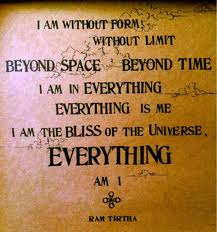Monday, October 31, 2011
All-Inclusive Interconnectivity
The Brahman Experience-Seat Of Freedom Essay Concluded
Distinctions Of Inside/Outside, Whole/Part, Cease To Be Meaningful
Winter ’80
Nishida went looking for "pure experience" and found it. In a pure
awakened state there is no distinction between transcendence,
immanence, and freedom. The "absolute free will," for Nishida, is at
the center of the creative world and lives through the "pulse of
creative nothingness." He used his own logic to characterize this
claim. To be fair, Nishida did not think of this logic in an
analytical sense, it was more a logic of existence. He called this
logic basho, and for me at least, this basho seems to be describing
three different levels of interconnectivity—the interconnectivity of
three different pulses of freedom.
Freedom is not a manifestation of being, it is the other way around;
out of creative nothingness arises the manifestation of being.
According to Nishida, everything that is, is within the
interconnectivity of the basho, and is at bottom, the basho of
"absolute nothingness." In all bashos a dual purpose is at work. As
the ground of everything, the logic of basho, works to support and
restrict all beings. Absolute nothingness becomes the heart and soul
of all beings, but tied to this basho is an invisible basho, the basho
of relative nothingness. "It," says Nishida, "exists only in relation
to the basho of being. It is the idea that nothingness is understood
in terms of its opposite: the notion of being." Interconnected with
all bashos-- relative nothingness, being, and absolute nothingness—is
the pulsing, creative nothingness that emerges from and returns to the
basho of absolute nothingness. I'm trying to understand this. I'm not
there yet. Here is a description of Nishida's basho as stated by Masaaki:
Nishida defines basho as "a predicate of predicates," a truly
universal, transcendent "place" in which subject and predicate are
mutually inclusive. Only the basho of "absolute nothingness" is truly
transcendent and truly universal. It is the place where the authentic
self turns around and becomes the "self without self." That means that
the "self as the basho" can reflect objects just as they are by truly
emptying itself, and can see things "by becoming things." Thus the
self as basho identifies itself with all beings in the absolute
contradictory mode of the world.
In this vision, “we get a feel" for how to resolve the paradox—the
paradox of how something--pure experience--can be both the source and
ground of being while at the same time been absolutely transcendent.
The being and the beyond distinctions that are present in the Hindu
and Buddhist distinctions of the Brahman/atman, self/not-self, are
dissolved in Nishida's basho. "When self-consciousness is completely
extinguished in the basho" says Nishida, "then the newborn `self as
the basho,' embodying the `unifying force' of absolute nothingness
from within, can fully exert its intrinsic nature as instrument to
become a creative force in the world." In the all-inclusive
interconnectivity of Nishida's basho, distinctions like
inside/outside, whole/part, cease to be meaningful.
It seems to me at least, according to what I am trying to understand
form the above, when everything is seen in full relief "just as it
is," in its suchness, there is an awakening. When all beings are seen
reflected in the absolute creative nothingness of the basho, there is
an awakening. In the experience of the absolute interpenetration of
nothingness with all the particular existents in the universe, there
is an awakening to the "eternal now." There, the distinctions
Brahman/atman, self/not-self, have no place. There, the newborn "self
as the basho," "self as absolute nothingness,'' wakes to perfect
freedom, perfect wisdom and perfect bliss. The fact that language will
not (can not) permit a description of "enlightened being," hasn't made
the paradox any less paradoxical. It's still there, with or without
language. I admire Nishida because of his struggles to get beyond that
paradox. However, I suspect that enlightenment—pure experience—is
necessary before "empty" and "full" can become one, before nirvana and
moksha can become one!
[Essay postscript: I was struggling when I wrote the above, but, intuitively,
I knew there was more to be discovered. I do not remember the date, but I will be posting (describing)—God willing, that experience as my journal unfolds. Here’s the crux of what I discovered:
The first structural liberation occurs between ~~p and ~pp, but the second structural liberation (the one that produces human consciousness) occurs only after a sufficient amount of diachronic evolution has transpired, i.e., a complexity sufficient to allow ~pp to reboot into the more liberated structure of p~p~pp, thus creating time of mind of consciousness, i.e., self-consciousness. The goal of all the above described spiritual disciplines—God by any other name, becomes manifest in the p~p~pp liberation of the “affirmative ideal” —the same “affirmative ideal” that liberated the source of meaningful symbol creation, which, in turn, opened the door to the creation of language, myth, religion, art, theoretical knowledge, and the rest of the civilizing processes that we call civilization.]
Subscribe to:
Post Comments (Atom)






No comments:
Post a Comment